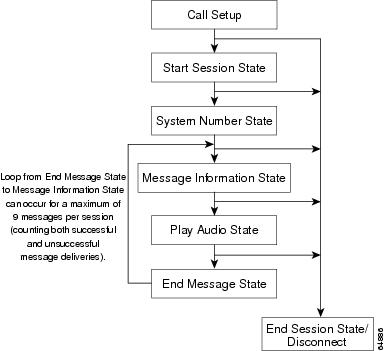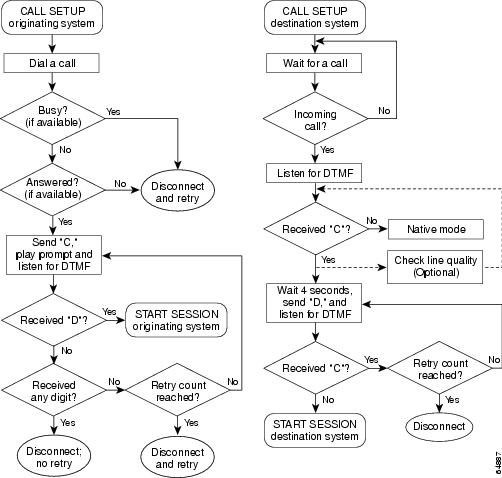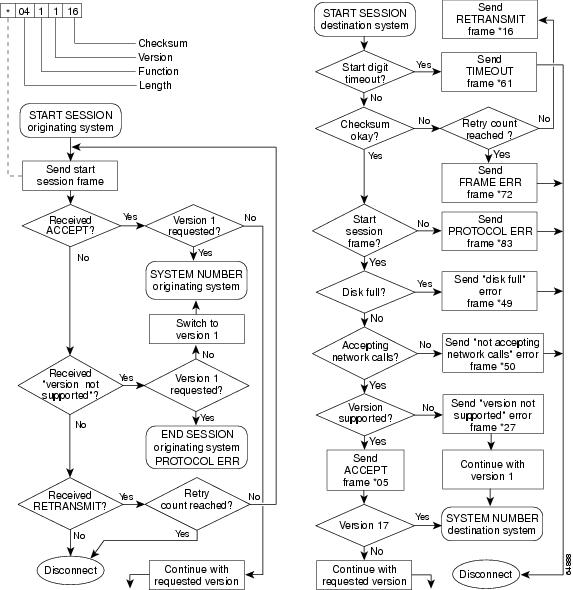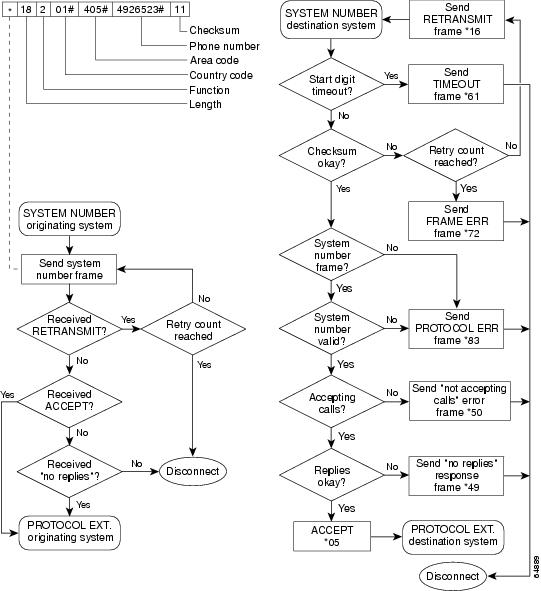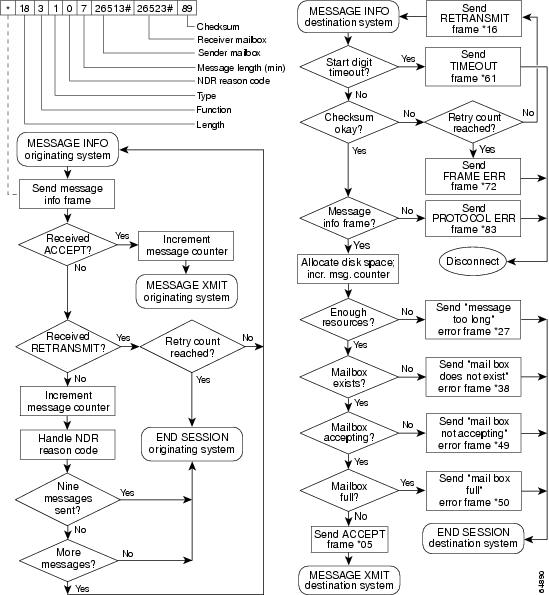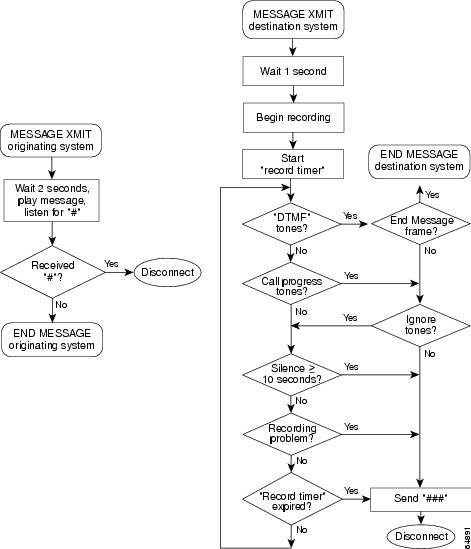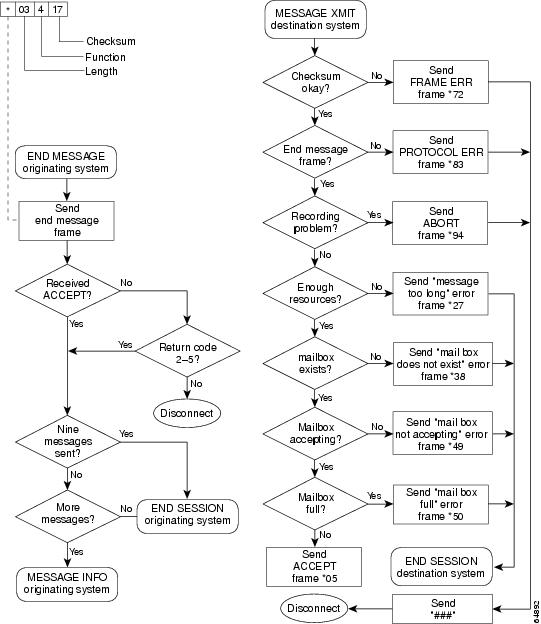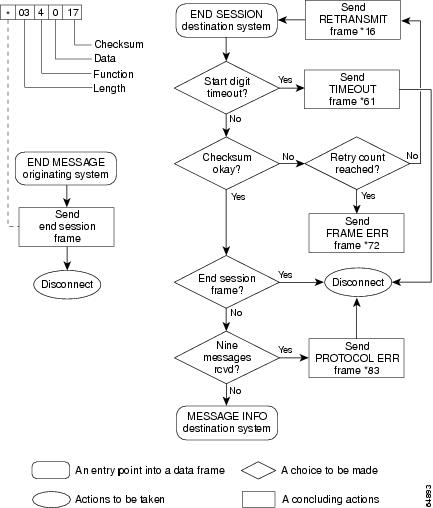Table Of Contents
White Paper: AMIS Analog Networking Definitions (All Cisco Unity Versions)
Frame Synchronization and Timing
Message Transfer Process—the AMIS Conversation
White Paper: AMIS Analog Networking Definitions (All Cisco Unity Versions)
Republished April 28, 2005
This white paper contains excerpts from the AMIS Protocol, and also includes an example of an AMIS conversation. This information provides the details necessary to help the reader decipher an AMIS call and troubleshoot a problem. However, it is not designed to replace the official AMIS Protocol.
Frame Structure and Timing
Control Signaling Frames
The Control Signaling frames are sequence dependent and meet specified syntax, Frame Length, and Checksum requirements. Data frames (sent by the originating system) have a 2-digit Checksum; Response frames (sent by the destination system) use a 1-digit Checksum. Variable-length fields are terminated with a "#" digit, which allows for flexibility of processing.
Frame Synchronization and Timing
The following protocol is followed to ensure that the Data frames and Response frames are not lost due to call disconnects, lost DTMF digits, or excessive processing delays:
•
After transmitting the last digit of a frame, the originating system waits for 1 second to avoid collecting echoed digits. It ignores any DTMF digits for this period.
•
The originating system then waits for a maximum of 10 seconds for the destination system to generate and begin sending the appropriate Response frame.
•
If, while receiving a frame, the destination system detects an Interdigit Timeout (5 seconds), it sends a Retransmit Response frame. If the Interdigit Timeout occurred while receiving a Response frame, the originating system generates an End Session Timeout frame and disconnects.
•
After receiving a frame, the destination system processes the frame and sends the appropriate Response frame after a 2-second delay, but not more than 8 seconds after receipt.
Frame Error Handling
Retransmission is allowed only for Frame Length, Interdigit Timeout, and Checksum errors.
Error: Failed to receive a Start Digit within Timeout period
•
Response, Originating System: Transmit an End Session Timeout frame, and disconnect call.
•
Response, Destination System: Transmit a Timeout Response frame, and disconnect call.
Error: Interdigit Timeout or Checksum error
•
Response, Destination System: Transmit a Retransmit Response frame. The originating system tries up to 2 more times to transmit the original frame. After a third attempt, the destination system transmits a Frame Error Response frame, and disconnects the call.
Error: Frame Length and Checksum pass, but syntax errors, invalid Data, or Out-of-Sequence frame has occurred
•
Response, Originating System: Transmit an End Session Protocol Error frame, and disconnect call.
•
Response, Destination System: Transmit a Protocol Error Response frame, and disconnect call.
Error: Line quality or other failed condition
•
Response, Originating System: Transmit an End Session Abort frame, and disconnect call.
•
Response, Destination System: Transmit an Abort Response frame, and disconnect call.
Message Transfer Process—the AMIS Conversation
Call Setup
The originating system dials the destination system number. Upon the absence of ringback tone, the originating system transmits a "C" tone to the destination. The originating system also transmits a voice message indicating that the recipient can press "l" to disconnect from the call, in the event that a human has answered the call. (If the recipient presses "1" to disconnect from the call, the originating system returns network messages to the sender with an error message.) If no response is received from the destination, the originating system retransmits the "C" tone up to a maximum of 7 tries. Retry schedules can then be put into effect.
If the destination system answers the call and detects the "C" tone, it responds with a "D" tone after a 4- to 6-second delay. After transmitting the "D" tone, the destination system expects a Start Session frame. If the destination system receives an additional "C" tone from the originating system, the destination system assumes that its "D" tone was not heard, and retransmits up to 3 times prior to disconnect.
If the originating system fails to detect a "D" tone response, a retry schedule can be put into effect. Failure to detect a "D" tone can occur for the following reasons:
•
Busy or intercept tone detected.
•
No answer condition.
•
No "D" tone response after the maximum allotted "C" tone transmissions.
•
Transmission problem, or protocol error.
Figure 1 shows the basic call processing sequence for AMIS communications.
Figure 1 AMIS Call Processing Sequence
In the following sections, only Function Codes, Response Codes, and specific Data field values will be described; note that all previously defined frame rules apply here as well. See the "Control Signaling Frames" section for basic Data frame code definitions.
Start Session State
This section describes the Data and Response frame definitions immediately after a network call has been established. The Data frame, sent by the originating system, defines the version of the AMIS analog protocol to be used.
System Number State
The System Number Data frame defines the Node ID of the originating system. This number should correspond to the call-back number of the originating system.
Message Information State
The Message Information Data frame defines the destination mailbox number, the sender's mailbox number, the type of message, and the approximate length of the message. The Response frame indicates that the message was accepted, or that the destination mailbox could not be located, that the destination mailbox is full, that the message is too long, and so on. If the destination accepts the message, it begins recording 1 second after sending an acceptance response. The originating system waits for 2 seconds before transmitting the actual voice message, to ensure that the destination is in record mode.
Table 7 Message Information Data Frame Codes
Function Code
3, which indicates a Message Information frame.
Data
Variable length, 7-37 digits (0-9 and #), as defined in the following table, Data Field Definitions for Message Information Data Frame Codes.
Play Audio/End Message State
Play Audio Message (Originating System) / Record Audio Message (Destination System)
Once a Message Information Acceptance Response Code is received from the destination system, the originating system transmits the audio message. If the message contains more than 10 seconds of continuous silence, DTMF tones, or network call progress tones, the destination system may disconnect the call. If the originating system receives a "#" during the transmission of the audio, it returns the message to the sender, and disconnects.
End Message (Originating System)
After transmitting the audio message, the originating system sends an End Message Data frame. If the destination system has successfully recorded the message, it transmits an Accept Response frame. However, if the destination system does not receive an End Message Data frame within the specified Message Length, or if it detects an interval of silence greater than 10 seconds, it transmits "###" and disconnects.
Table 10 End Message Data Frame Codes
Function Code
4, which indicates an End Message frame.
Data
None.
At the end of the transmission of a message, if the originating system has additional messages to deliver, it transmits a Message Information Data frame, and starts the process again (up to 8 times, for a maximum of 9 messages per call). When there are no more messages to be sent, or when the maximum 9 messages have been sent, the originating system transmits an End Session Data frame.
End Session State
The End Session Data frame indicates that the originating system has no further messages to send, or that the maximum 9 messages per call have been sent.
Table 13 End Session Response Frame Codes
Response Code
None. Call is disconnected.
AMIS Conversation Example
The following is a representation of the successful AMIS transmission of 1 message, as seen and heard on a Digit Grabber or Ziad.
(Ringing)CCD*041116*05*1721#408#2327200#05*49*1630015555#9995#07*05(Voice message plays here)*03417*05*049033Table 14 shows a detailed breakdown of the digits.
AMIS Analog Flow Charts
The following flow charts show the sequence of actions and the specific frames sent and received during each state of an AMIS conversation.
In all of the flow charts, the shapes are defined as shown in Figure 2.
Figure 2 Flow Chart Legend
Figure 3 Call Setup
Figure 4 Start Session State
Figure 5 System Number State
Figure 6 Message Information State
Figure 7 Message Transmit State
Figure 8 End Message State
Figure 9 End Session/Disconnect
CCIP, CCSP, the Cisco Arrow logo, the Cisco Powered Network mark, Cisco Unity, Follow Me Browsing, FormShare, and StackWise are trademarks of Cisco Systems, Inc.; Changing the Way We Work, Live, Play, and Learn, and iQuick Study are service marks of Cisco Systems, Inc.; and Aironet, ASIST, BPX, Catalyst, CCDA, CCDP, CCIE, CCNA, CCNP, Cisco, the Cisco Certified Internetwork Expert logo, Cisco IOS, the Cisco IOS logo, Cisco Press, Cisco Systems, Cisco Systems Capital, the Cisco Systems logo, Empowering the Internet Generation, Enterprise/Solver, EtherChannel, EtherSwitch, Fast Step, GigaStack, Internet Quotient, IOS, IP/TV, iQ Expertise, the iQ logo, iQ Net Readiness Scorecard, LightStream, MGX, MICA, the Networkers logo, Networking Academy, Network Registrar, Packet, PIX, Post-Routing, Pre-Routing, RateMUX, Registrar, ScriptShare, SlideCast, SMARTnet, StrataView Plus, Stratm, SwitchProbe, TeleRouter, The Fastest Way to Increase Your Internet Quotient, TransPath, and VCO are registered trademarks of Cisco Systems, Inc. and/or its affiliates in the U.S. and certain other countries.
All other trademarks mentioned in this document or Web site are the property of their respective owners. The use of the word partner does not imply a partnership relationship between Cisco and any other company. (0304R)
White Paper: AMIS Analog Networking Definitions (All Cisco Unity Versions with Microsoft Exchange)
Copyright © 2003, Cisco Systems, Inc.
All rights reserved.
